Whether it’s the first flush of spring, the heights of summer, or the fading colors of autumn and winter, we all enjoy filling our homes with the vitality and fragrance of flowers. While humans of a certain age and behind are highly unlikely to venture a taste of these vibrant blossoms, feline curiosity is an entirely different matter. Flowers like roses, sunflowers, and petunias delight our senses; but some plants pose poisonous dangers to our cats. Here’s a list of 10 highly popular flowers that, though beautiful, can be toxic or even deadly to cats, as well as a guide on keeping your cats safe.
1. Aloe Vera (Genus Aloe barbadensis miller)
Usage
People have celebrated Aloe vera for its diverse applications for thousands of years. Known for its succulent leaves filled with nourishing gel, they commonly use it for:
Medicinal Purposes
People revere Aloe vera juice for providing health benefits such as relieving heartburn, treating constipation, and potentially improving symptoms of irritable bowel syndrome (IBS). Researchers are also exploring it for managing blood sugar levels in individuals with type 2 diabetes.
Skincare
Topically, the aloe-based gel can help improve acne, hasten burn recovery, and even moisturize the skin. Researchers have also explored it as a bacterial inhibitor on fruits and vegetables.
Oral Health
Aloe vera extract can be a safe and effective alternative to chemical-based mouthwashes, providing relief for oral health issues like plaque and sore gums. High doses, on the other hand, can be hazardous, and it may interfere with certain drugs, especially glucose-lowering treatments. Always check your doctor before using any supplement.
Decorative
Its pleasing appearance makes it a popular choice for home and garden decoration.
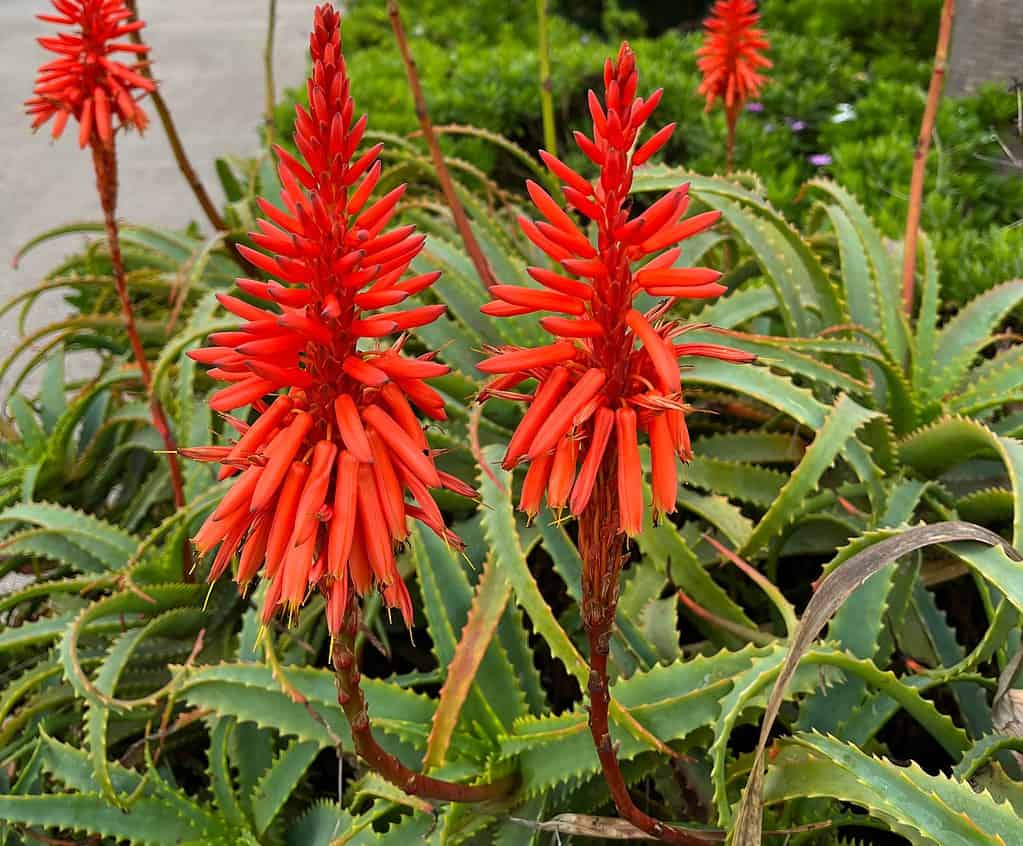
Aloe vera plants have many benefits to humans, but are harmful to cats
©Alex_o_photography/Shutterstock.com
Toxicity to Cats
While aloe vera is frequently lauded for its numerous health advantages for humans, this flower poses considerable hazards to our cat companions.
Contains Saponins
Saponins are chemicals that can cause vomiting, diarrhea, and lethargy in cats. Unlike humans, who may benefit from the plant’s health benefits, cats metabolize saponins differently, resulting in harmful effects.
Preventative Measures
If you have a cat and prefer keeping aloe vera in your home for its medicinal virtues, keep it out of reach of your feline friends. If you feel your cat has encountered aloe vera, seek immediate medical attention because fast treatment can be critical to their recovery.
2. Azalea (Genus Rhododendron spp.)
Usage
People know Azaleas as lovely flowering shrubs that they frequently utilize in landscaping and garden décor. They have selectively developed over 10,000 different cultivars for ages, and these are famed for their spectacular spring bloom.
Cultural Importance
Cities such as Mobile, AL, Houston, TX, Valdosta, GA, and Wilmington, NC have azalea festivals, trails, and activities to commemorate their cultural significance. And that’s only in the United States.
Toxicity
Azaleas, which contain andromedotoxins (also known as grayanotoxins), are highly dangerous to both people and animals if consumed. Toxins can cause symptoms such as drooling, vomiting, atrial-ventricular blockage, and more.

Celebrated azaleas should remain at least a couple paws’ length from your cat
©Cvandyke/Shutterstock.com
3. Begonia (Genus Begonia)
Usage
People know Begonias, with over 2,000 kinds, as attractive plants that they can find in subtropical and tropical climates or grow at home.
Variety
Begonia hybridization has resulted in a vast range of cultivars with complex nomenclature and various traits.
Toxicity
Begonias contain soluble calcium oxalates, which can induce mouth discomfort, drooling, and vomiting. Some species are edible due to the presence of oxalic acid. However, you should use caution and consult your doctor before ingesting them.
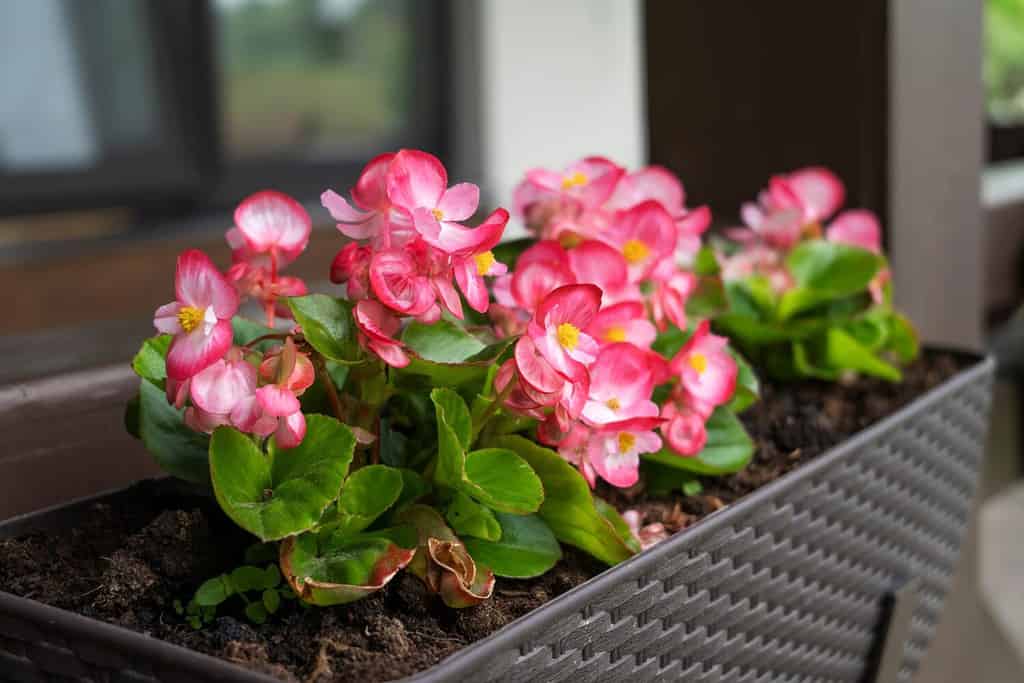
Though they look like a snack of a flower, begonias can be toxic to both humans and felines
©IRINA CHETVERIKOVA/Shutterstock.com
4. Bird of Paradise Flower (Genus Strelitzia reginae)
Usage
People recognize the Bird of Paradise as a popular ornamental plant known for its spectacular blossoms that resemble a bird’s head and beak. This resemblance makes it extra attractive to cats. People grow it both outside in sunny areas and indoors as a houseplant.
Cultural and Symbolic Importance
People see this flower as a symbol of paradise, freedom, and joy. It carries particular cultural significance in Hawaii, marks a ninth wedding anniversary, and is featured on the 50-cent coin in South Africa.
Toxicity
Though primarily employed as a decorative plant, consumption can cause moderate digestive problems such as vomiting or nausea.

Also known as the Crane Flower, the Bird of Paradise mesmerizes people worldwide, so imagine how interested a cat would be in it
©SaskiaAcht/Shutterstock.com
5. Calla Lily (Genus Zantedeschia)
Usage
Calla lilies are popular as decorative plants due to their enormous and spectacular blossoms. People grow them in home gardens on all continents except Antarctica (unless an enterprising arctic researcher proves otherwise), and they are a favorite cut flower.
Appearance
These herbaceous perennials produce striking flowers with a white or yellow spathe encircling a center spadix. People also know them to produce orange or red beaked fruit.
Symbolism
People have represented Calla lilies in art and linked them to religious symbolism throughout history, associating them with purity, rebirth, and resurrection.
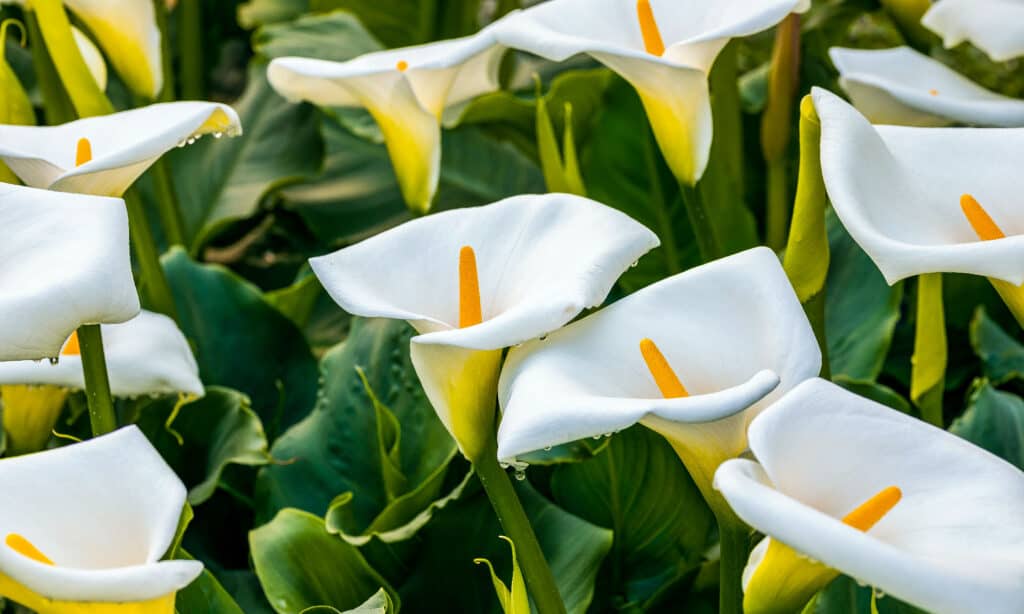
Angelic and pure, but deadly to both humans and cats, are the calla lily
©Fabrizio Guarisco/Shutterstock.com
Toxicity
Calla lilies are extremely hazardous to humans and animals because they contain insoluble calcium oxalates, which induce severe mouth irritation and drooling. Any portion of a raw calla lily can be lethal. Cat parents must be very cautious with this flower, especially with varieties that people consider toxic weeds.
Fascinating Fact
Calla lilies, despite their name, are not genuine lilies. Their fascinating history and peculiar growth in mud or shallow water, reaching up to 3.3 feet, make them appealing to people of all cultures.
6. Carnation (Genus Dianthus caryophyllus)
Usage
Carnations are popular as cut flowers, ornamental in gardens, and in scented items such as fragrances and potpourri because of their brilliant colors, delicate petals, and enticing aroma.
Cultural Importance
Carnations have a lengthy cultural heritage. People recognize them as the national flower of Spain, Monaco, and Slovenia, and associate them with love, distinction, maternal devotion, and other emotions. People give them as gifts on Parents Day in South Korea and as funeral flowers in France. And of course, high schoolers in the United States often wear them to prom.
Symbolism and Variation
Carnations come in a wide range of colors and shapes, and each color represents a different meaning. Breeders genetically altered them to generate blue-mauve and violet types, which became commercially available in the late 1990s.
Versatility
People appreciate carnations for their versatility, as they are edible and have historically been used in medicinal treatments. People also used them to communicate hidden messages throughout the Victorian era and associate them with birth months, anniversaries, and even secret messages.
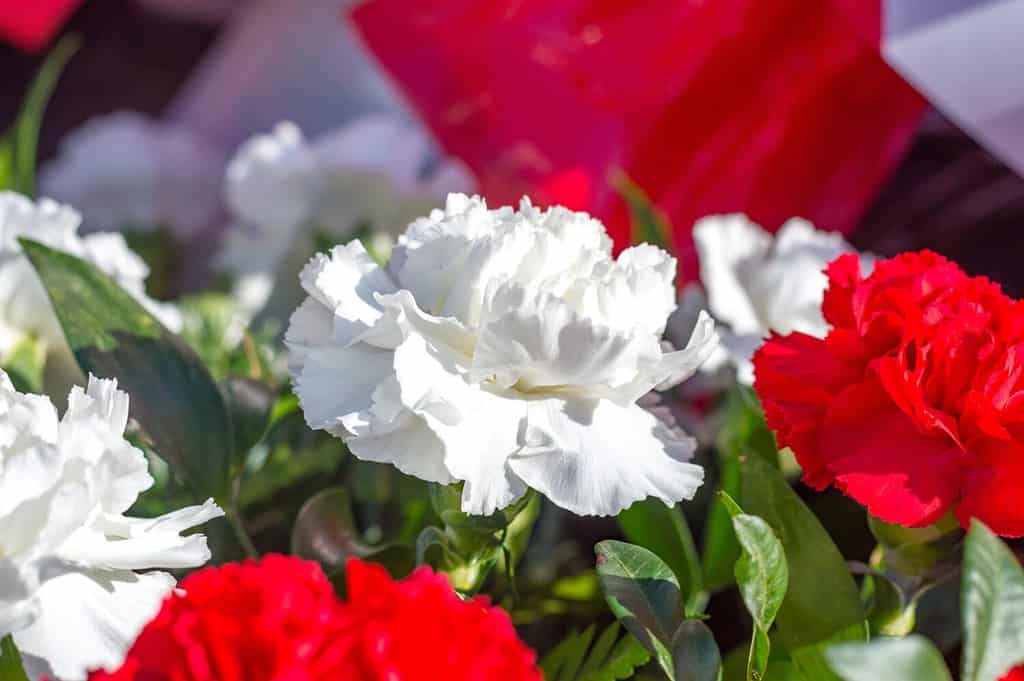
While harmful to cats if ingested, carnations are not as toxic as some other flowers in this list
©Robson90/Shutterstock.com
Toxicity
People generally regard carnations as harmless for humans and animals, even though they may induce moderate gastrointestinal issues. If you must keep them around, keep them out of paws’ reach, since this flower may cause some issues for your cat.
Fascinating Fact
People historically wore Carnations, also known as the “flower of the gods,” by Oxford university students during exams for good luck. Their enduring meaning of beauty and grace is enhanced by their history as one of the earliest cultivated flowers.
7. Chrysanthemum (Genus Chrysanthemum)
Usage
Ornamental, Tea, Medicinal
East Asian and northeastern Europe peoples have cultivated chrysanthemums, also known as mums or chrysanths, for almost 3,000 years. They have become popular decorative plants due to their beautiful blooms and wide range of colors, styles, and sizes. People have utilized the blooms in traditional Chinese medicine and celebrate them in Chinese and Japanese festivals. Garden hardy and exhibition kinds of chrysanthemums are available nowadays.
In China, chrysanthemum tea is a famous and healthy drink produced from the flowers. Furthermore, people employ pyrethrum, a chemical component present in chrysanthemums, in pesticides, demonstrating both medical and practical applications.

The mesmerizing color gradients of chrysanthemums are great to experience visually, but do no not allow your cat to ingest
©StopperOhana/Shutterstock.com
Toxicity: Pyrethrins
The pyrethrins found in chrysanthemums can cause drooling, vomiting, and coordination issues. These toxic consequences are very pronounced in some animals, and exposure should be handled with caution.
8. Daffodil (Genus Narcissus)
Usage
Ornamental, Cut Flowers
Narcissus, sometimes known as daffodils, is a genus of perennial flowering plants recognized for their brilliant, showy flowers with six petal-like tepals and a cup-shaped corona. They are native to southern Europe and North Africa and have a long history of cultivation and breeding, yielding thousands of various cultivars.
People often use these lovely blossoms in gardens and as cut flowers. They recognize them as the official flower for the 10th wedding anniversary and regard them as Wales’ national flower. Daffodils bloom in the spring, with early, mid, and late bloomers providing a long period of splendor.
Toxicity: Lycorine
Daffodils contain lycorine, a chemical that can induce severe gastrointestinal problems, including vomiting. While the plant is very appealing, eating any part of it, particularly the bulb, which contains the highest quantity of lycorine, can be toxic.
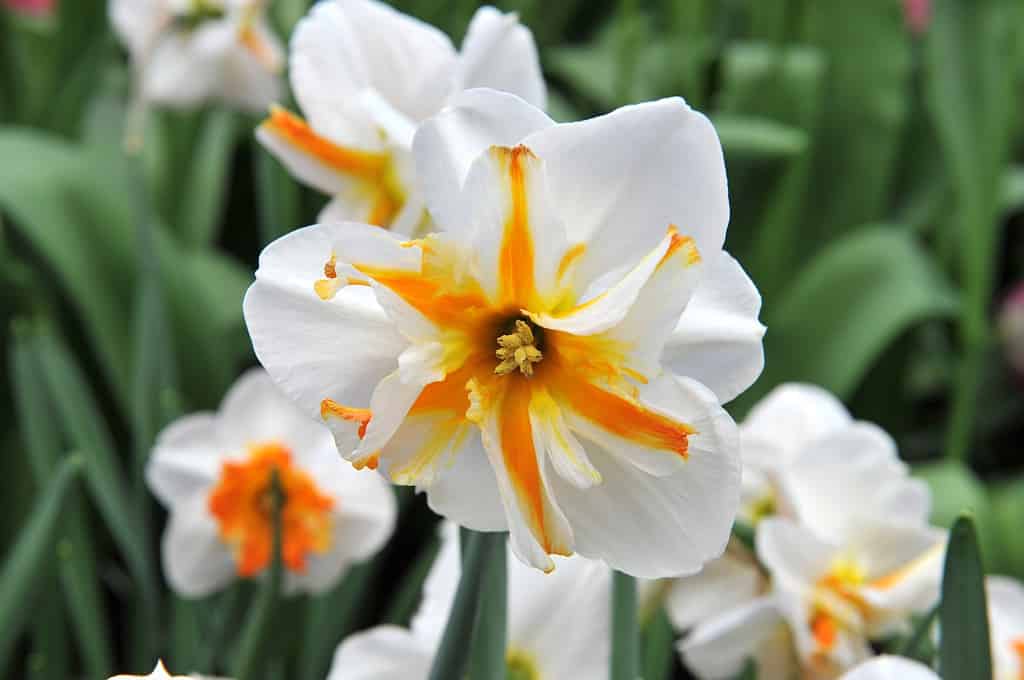
“Trepolo” Split-Cupped Papillion Daffodils equals severe tummy aches for your kitty
©Sergey V Kalyakin/Shutterstock.com
9. Dahlia (Genus Dahlia)
Usage
Ornamental, Cut flowers
Description
The dahlia is a flowering plant genus native to Mexico and Central America, with a wide range of flower styles and brilliant colors. There are 49 species and thousands of variants and cultivars, which are classified by size, bloom pattern, and similarity to other flowers. True blue or black dahlias do not exist, despite the wide variation.
History and Importance
The Aztecs used Dahlias as a food crop before people designated them as Mexico’s national flower in 1963. The introduction to Europe in the 18th century resulted in the discovery and classification of multiple species, as well as the formation of new variants through hybridization. They were originally categorized as vegetables because of their edible tubers, which taste like a cross between potatoes and radishes.
Meaning in Culture and Symbolism
Dahlias represent dedication, strength, creativity, and elegance. They are popular wedding flowers with a long history that dates to Central America.
Toxicity
Mild digestive discomfort is possible; however, it is typically regarded as non-toxic.
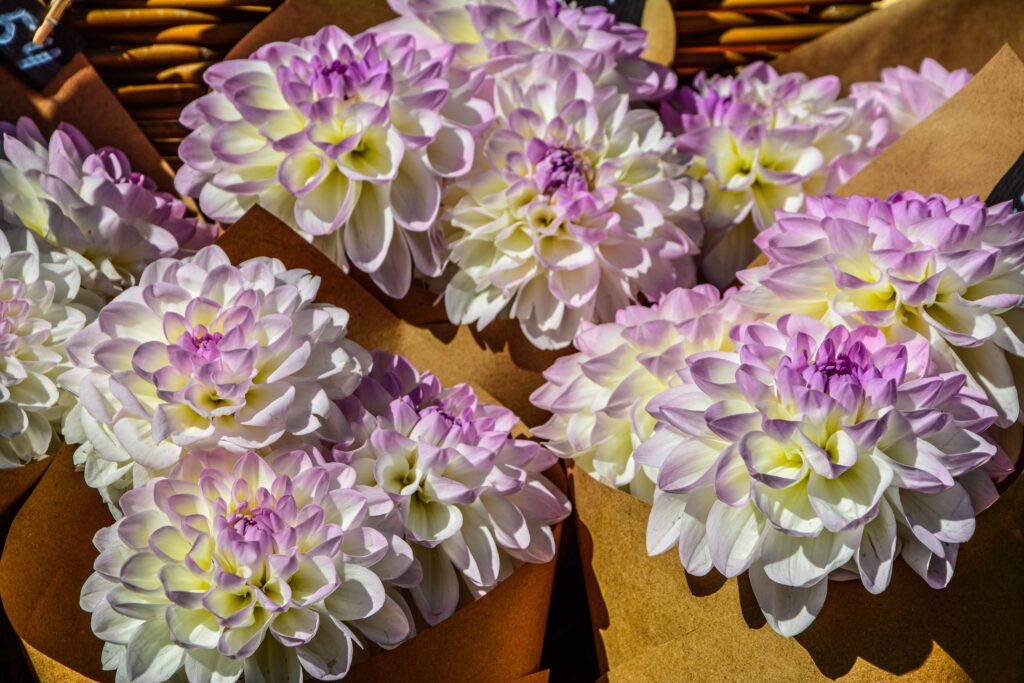
Though its hard to see the relation visually, the dahlia is a relative of the sunflower
©Weha/Shutterstock.com
10. Daisy (Genus Bellis, of Family Asteraceae)
Usage
Ornamental, Cut flowers
Description
The daisy is a member of the Asteraceae family, which comprises over 32,000 species like asters, sunflowers, and composites. The composite flower head of these plants, made up of numerous smaller blooms, gives them a star-like look. Daisy types include Gerbera daisies, which are available in eight different colors, and Shasta daisies.
History and Importance
The term “daisy” comes from the Old English phrase “day’s eye,” which refers to the flower’s habit of opening and shutting its petals in time with the sun’s rising and setting. For years, daisies have been a familiar sight in gardens around the world, signifying innocence, purity, loyalty, patience, and simplicity.
Cultural and Medicinal Applications
Daisy flowers offer edible and medicinal characteristics in addition to their decorative appeal, making them versatile and beneficial plants. Children used them in Victorian times to build May Day crowns, and people find some species edible. Furthermore, bees are particularly drawn to some species of daisies, such as Shasta daisies, which improves pollination in gardens.

Daisies are generally great, but contain neurotoxins that, if ingested in large enough quantities, can spell trouble for your cat
©Wonderplay/Shutterstock.com
Toxicity
Pyrethrins can cause gastrointestinal problems, drooling, and even unusual neurological signs.
Why Are These Flowers Toxic to Felines?
These flowers are poisonous to cats due to specific chemicals and compounds, such as alkaloids, glycosides, oxalates, saponins, essential oils, and irritant sap. Ingestion of toxic plants may lead to symptoms ranging from irritation and inflammation to organ-specific effects, such as kidney failure.
Prevention and Treatment
To protect our beloved cats, it’s essential to accurately identify and remove these poisonous plants from our homes. If you suspect ingestion, they should seek immediate care, as treatment may include medication, supportive care, and close monitoring. Some cases may require prolonged aftercare or special diets.
In addition to these 10 flowers, lilies, tulips, hydrangeas, and others are also harmful to cats. Creating a cat-safe environment both indoors and outdoors by choosing safe plants like asters, lilacs (the common one, Syrina vulgaris, not the Persian Melia genus, which is highly toxic), roses, orchids, and sunflowers is essential. If you suspect your cat has been poisoned, contact a vet immediately, and do not wait for signs of illness to develop.
Conclusion
Our furry companions depend on us to keep them safe. By recognizing and avoiding plants that are harmful to them, and by knowing what to do if a cat ingests an attractive yet toxic flower, we can ensure a happy and healthy environment for our pets. Let’s build a garden and make arrangements we can all enjoy together!
Thank you for reading! Have some feedback for us? Contact the AZ Animals editorial team.








